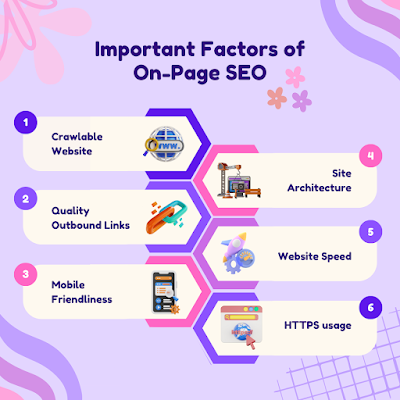A Comprehensive Guide to Boosting Your Website's Visibility
In the ever-evolving landscape of digital marketing, Search Engine Optimization (SEO) remains an indispensable tool for improving a website's visibility and driving organic traffic. One crucial aspect of SEO is On-Page SEO, which involves optimizing various elements on a webpage to enhance its search engine ranking. Let's delve into some vital factors that contribute to effective On-Page SEO and explore how they can elevate your website's performance.
1. Crawlable Website:
Creating a crawlable website means ensuring search engine bots can easily navigate and index your site's content. This involves utilizing a clear and logical URL structure, creating an XML sitemap, and using robots.txt to guide search engines on which pages to crawl.
Example:
Suppose you have an e-commerce website selling electronics. Structuring URLs like "yoursite.com/electronics/laptops/dell-xps-15" enables search engines to comprehend your content hierarchy.
2. Site Architecture:
A well-organized site architecture improves user experience and helps search engines understand the relative importance and relationship between different pages. A clear and intuitive navigation structure is crucial for both visitors and search engines.
Example:
Implement a breadcrumb navigation trail on your website to help users easily navigate through categories and subcategories, enhancing their overall browsing experience.
3. Quality Content:
Quality, relevant, and engaging content is the cornerstone of On-Page SEO. Craft content that addresses users' needs, provides value, and aligns with their search intent. Use relevant keywords naturally and offer solutions to users' problems.
Example:
If you run a health and wellness blog, an article detailing "10 Tips for a Healthy Diet" not only provides valuable information but also incorporates relevant keywords related to diet and health.
4. Outbound Links:
Strategic use of outbound links to authoritative and reputable sources can boost your website's credibility. It demonstrates that your content is well-researched and supported by trusted sources.
Example:
In an article about digital marketing trends, linking to reputable marketing websites like HubSpot or Neil Patel's blog can enhance the article's reliability.
5. Website Speed:
Page speed directly impacts user experience and SEO. A faster website improves bounce rates, user engagement, and search engine rankings. Optimize images, leverage browser caching, and minimize HTTP requests to enhance loading speed.
Example:
Use tools like Google PageSpeed Insights to analyze your website's speed and receive suggestions for improvements.
6. Mobile Friendliness:
Given the surge in mobile internet usage, having a mobile-friendly website is non-negotiable. Google prioritizes mobile-first indexing, so ensure your website is responsive and delivers an excellent experience on smartphones and tablets.
Example:
Test your website using Google's Mobile-Friendly Test tool to ensure it meets mobile usability standards.
7. HTTPS Usage:
HTTPS (Hypertext Transfer Protocol Secure) encrypts data between the user's browser and your website. It not only enhances security but is also favored by search engines for ranking purposes.
Example:
Implement an SSL certificate on your website, and verify its installation with tools like SSL Labs.
Incorporating these vital On-Page SEO factors can significantly impact your website's visibility, user experience, and ultimately, your success in the digital realm. By continually optimizing and fine-tuning these elements, you're positioning your website for greater success in search engine rankings and increased organic traffic.













0 Comments